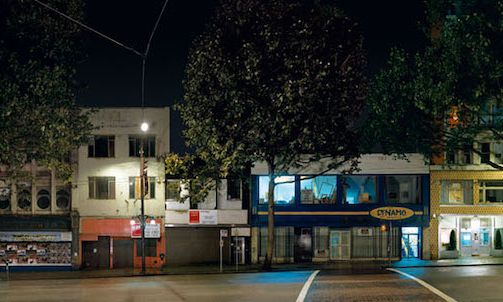Stan Douglas, Every Building on 100 West Hastings, 2001 Courtesy the artist and Chinatown Foundation
Vancouver, Canada’s third-largest city, is famous for both its vibrant contemporary art scene and its housing crisis. Tomorrow night (9 November) the two will come together in an event that will see works by the city’s best-known contemporary artists auctioned off at a Chinatown Foundation gala to support housing for the homeless in the city’s historically significant yet troubled Downtown Eastside.
Vancouver artist Angela Grossman liaised with Chinatown Foundation chair Carol Lee a year ago to integrate art into the housing project and hatched the idea of a fundraising auction. Grossman’s studio is in the area that was once Vancouver’s downtown before midcentury shifts, the after-effect of Expo 86 and housing, mental healthcare and addiction crises took their toll. It is now Canada’s poorest postal code. The artists she approached to lend their work, she tells The Art Newspaper, “have also lived and worked in the neighbourhood (which comprises Chinatown). They feel a part of the community. Everyone we asked said ‘yes’ right away.
Angela Grossmann, WORK, 2021 Courtesy the artist and Chinatown Foundation
Grossman is among the seven artists—along with Stan Douglas, Ken Lum, Lawrence Paul Yuxweluptun, Dana Claxton, Doug Coupland and Martha Sturdy—who have donated work to the fundraiser. The auction is in aid of a new social housing and healthcare project at 58 West Hastings Street funded by the Chinatown Foundation and civic, provincial and federal governments. For security reasons originals cannot be used, so instead a high-end replica of each piece will be installed on each floor on the seven-storey social housing complex. Art and culture-related activities are planned for the residents of the 230 new affordable housing units, who are expect to move in by the summer of 2024.
Among the many important works, the contribution by Douglas—who represented Canada at the 2022 Venice Biennale—stands out as a kind of homecoming. His sprawling work Every Building on 100 West Hastings (2001), in a 16ft-wide chromogenic print from his own private collection, will be available for sale for the first time in over a decade. It’s listed for sale starting at C$339,000 (or around $250,000), and organisers hope a major institution or collector might acquire it.
There is speculation that collector and philanthropist Michael Audain, who co-chaired the art committee for the 58 West Hastings project, might be a prime bidder, but as the “Vancouver school” of photo-conceptualists has gained international recognition, the field is still wide open. The Chinatown Foundation still needs to fundraise another C$8m ($5.8m) of its promised C$30m ($21.8m) contribution toward the total capital cost of C$110m ($80m) for the project, which will also include a health care centre. (The works are being offered online ahead of Thursday night's in-person fundraising auction.)
Douglas’s work, which captures the full southside 100 block of Vancouver's West Hastings Street—the gateway to the Downtown Eastside and just steps from the site of the new social housing project—is a testament to the brunt of gentrification borne by the street’s Edwardian buildings. Their demise speaks to the struggles of the local community that the new housing project hopes to address.
The piece itself was created by photographing each building and compositing the individual prints into a manipulated yet hyper-realistic perspective. A book of essays about the work was published by Vancouver’s Arsenal Press with a removable, full-colour poster.
Lawrence Paul Yuxweluptun, Man in the Woods, 2023 Courtesy the artist and Chinatown Foundation
“Housing is one of the most fundamental problems facing our city and for the Chinatown Foundation to step up and address that is pretty amazing,” Douglas said in a statement. “When they approached me about donating a work, they were expecting something more modest but given the proximity of 58 West Hastings to the 100 block it felt like an opportunity for the neighbourhood to retain the memory of itself within itself.”
Lum grew up in the Chinatown area, and his work—a photograph created especially for the project and titled Lau Hoi Ting Recalls a Poem of Her Youth (2023)—pays homage to his strong connection to the community. “My grandfather was acook at the Only Seafood. My father waited on tables at the Smilin' Buddha (an iconic cabaret turned punk venue). My mother worked at a laundry on Keefer near Main,” Lum says. “The people of the area have been forsaken. They deserve better, and this project is an all too rare hopeful step.”

